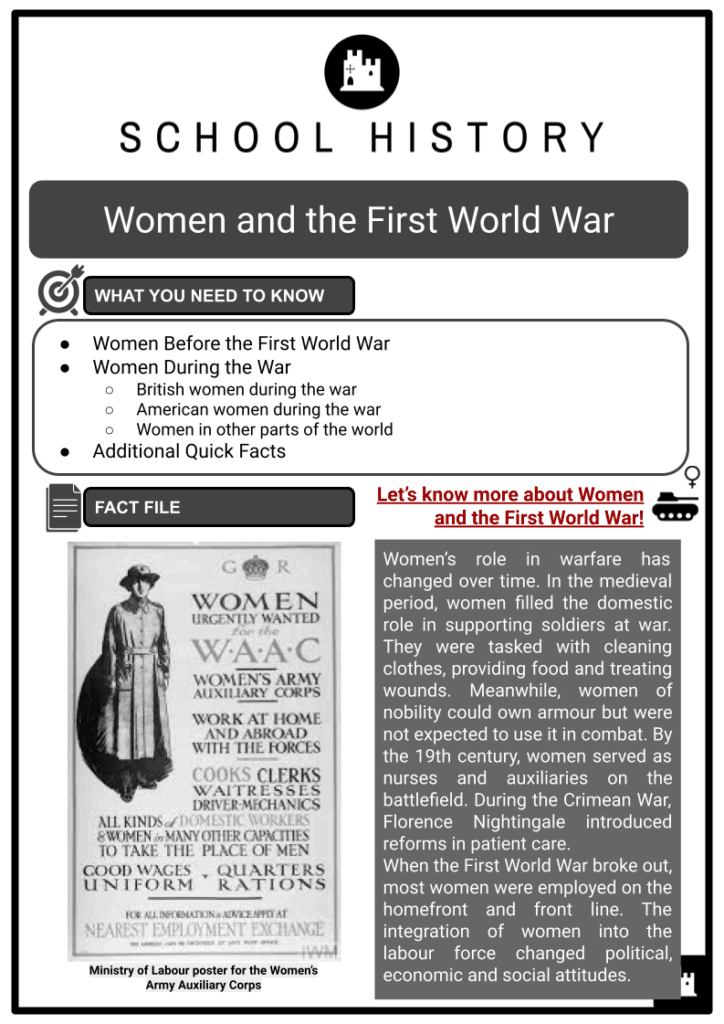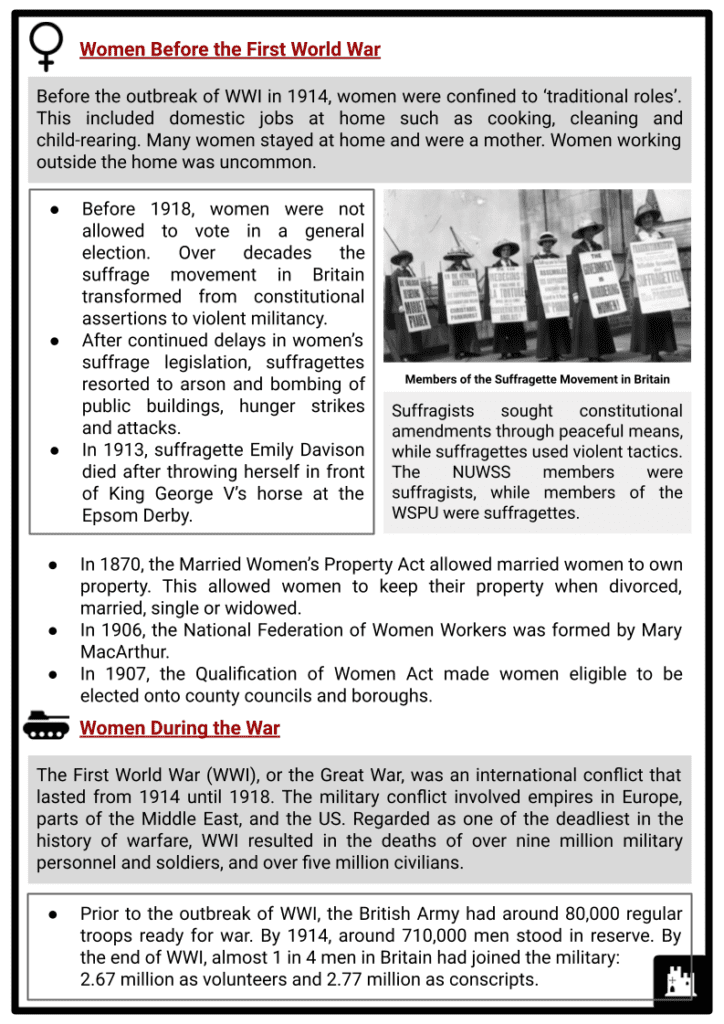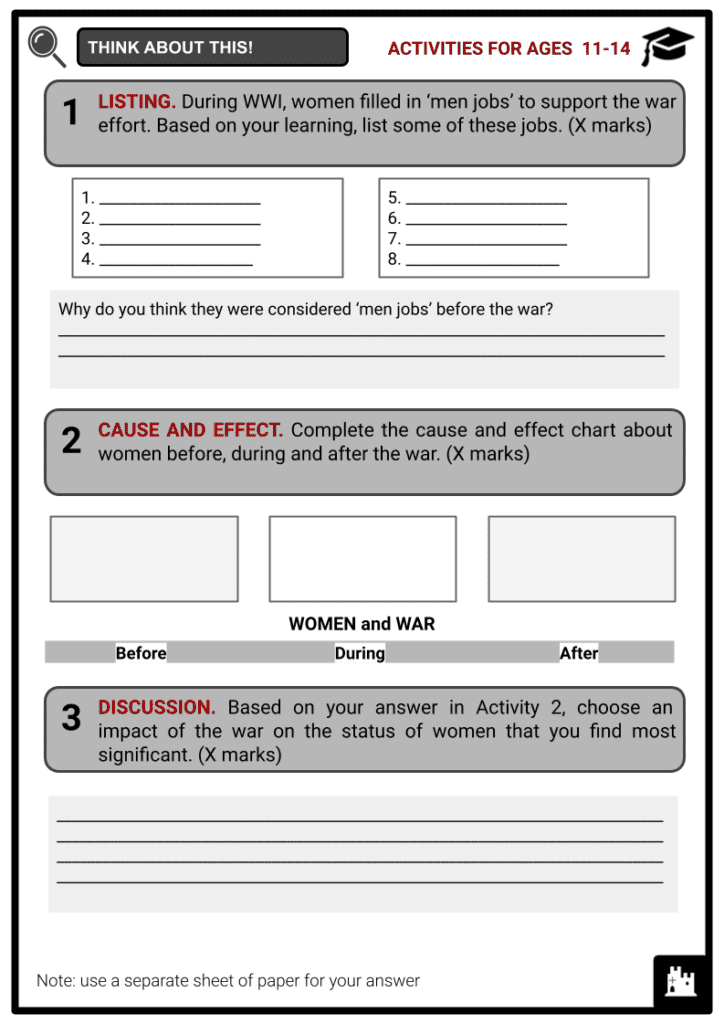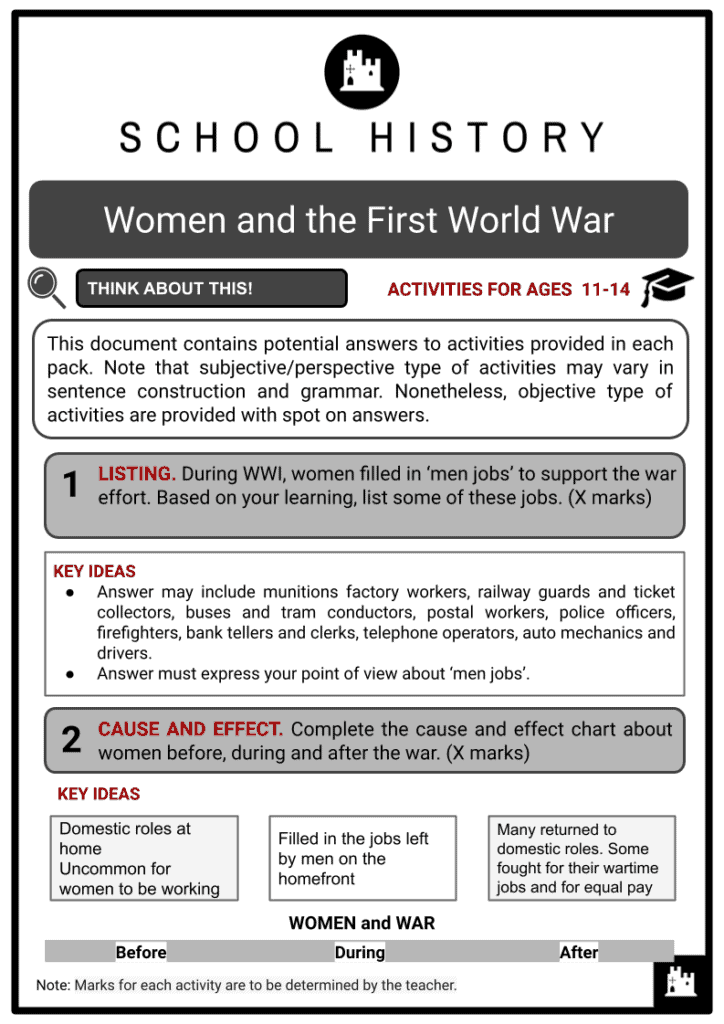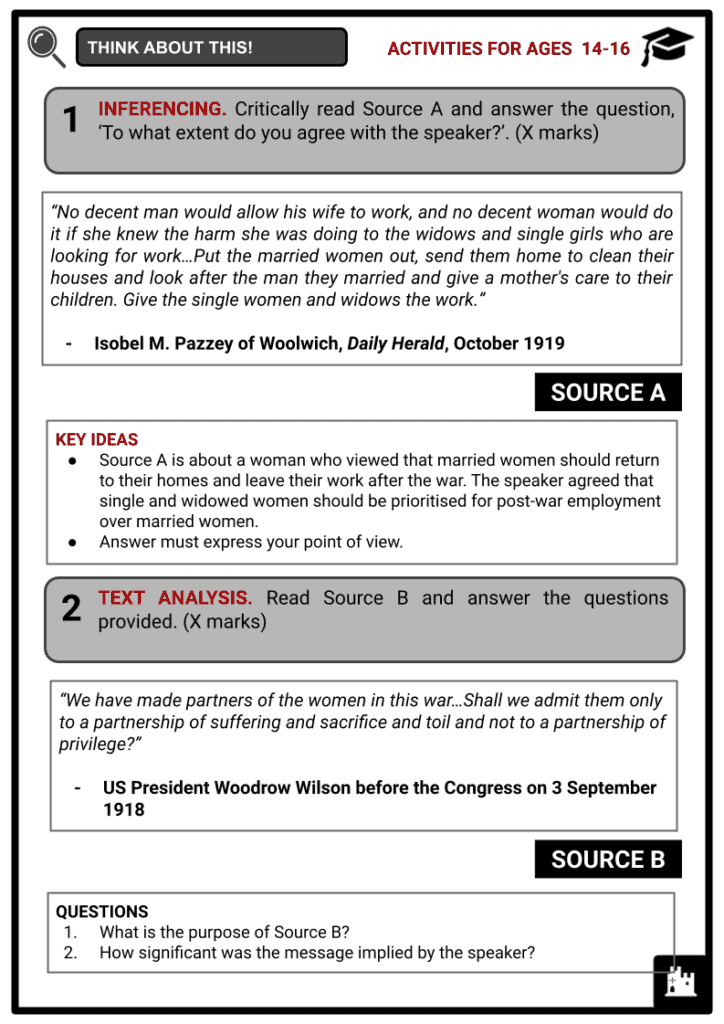Download Women and the First World War Worksheets
Do you want to save dozens of hours in time? Get your evenings and weekends back? Be able to teach about Women and the First World War to your students?
Our worksheet bundle includes a fact file and printable worksheets and student activities. Perfect for both the classroom and homeschooling!
Table of Contents
Add a header to begin generating the table of contents
Summary
- Women Before the First World War
- Women During the War
- British women during the war
- American women during the war
- Women in other parts of the world
- Additional Quick Facts
Key Facts And Information
Let’s know more about Women and the First World War!
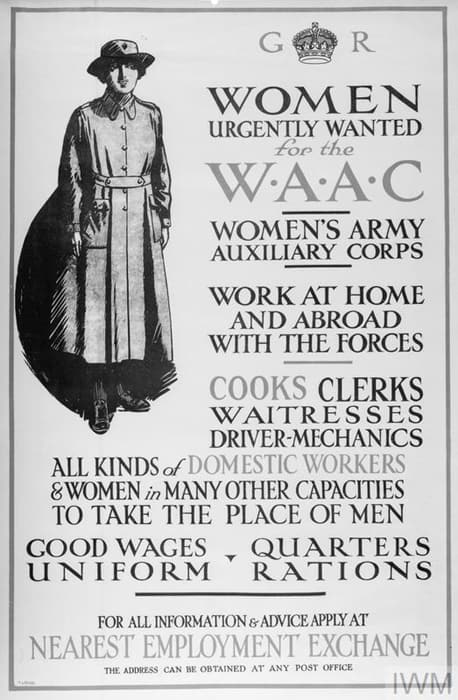
- Women’s role in warfare has changed over time. In the medieval period, women filled the domestic role in supporting soldiers at war. They were tasked with cleaning clothes, providing food and treating wounds. Meanwhile, women of nobility could own armour but were not expected to use it in combat. By the 19th century, women served as nurses and auxiliaries on the battlefield. During the Crimean War, Florence Nightingale introduced reforms in patient care.
- When the First World War broke out, most women were employed on the homefront and front line. The integration of women into the labour force changed political, economic and social attitudes.
Women Before the First World War
- Before the outbreak of WWI in 1914, women were confined to ‘traditional roles’. This included domestic jobs at home such as cooking, cleaning and child-rearing. Many women stayed at home and were a mother. Women working outside the home was uncommon.
- Before 1918, women were not allowed to vote in a general election. Over decades the suffrage movement in Britain transformed from constitutional assertions to violent militancy.
- After continued delays in women’s suffrage legislation, suffragettes resorted to arson and bombing of public buildings, hunger strikes and attacks.
- In 1913, suffragette Emily Davison died after throwing herself in front of King George V’s horse at the Epsom Derby.
- Suffragists sought constitutional amendments through peaceful means, while suffragettes used violent tactics. The NUWSS members were suffragists, while members of the WSPU were suffragettes.
- In 1870, the Married Women’s Property Act allowed married women to own property. This allowed women to keep their property when divorced, married, single or widowed.
- In 1906, the National Federation of Women Workers was formed by Mary MacArthur.
- In 1907, the Qualification of Women Act made women eligible to be elected onto county councils and boroughs.
Women During the War
- The First World War (WWI), or the Great War, was an international conflict that lasted from 1914 until 1918. The military conflict involved empires in Europe, parts of the Middle East, and the US. Regarded as one of the deadliest in the history of warfare, WWI resulted in the deaths of over nine million military personnel and soldiers, and over five million civilians.
- Prior to the outbreak of WWI, the British Army had around 80,000 regular troops ready for war. By 1914, around 710,000 men stood in reserve. By the end of WWI, almost 1 in 4 men in Britain had joined the military: 2.67 million as volunteers and 2.77 million as conscripts.
British women during the war
- Because of the introduction of conscription in 1916, the government launched campaigns and recruitment drives, as female workers were really needed. Large numbers of women took jobs left by men who had gone to fight in the war.
- New jobs were created as part of the war effort. For example, many women worked in munitions factories. In fact, it was one of the largest sources of employment in 1918.
- Women began to work ‘men jobs’ such as railway guards and ticket collectors, buses and tram conductors, postal workers, police officers, firefighters and as bank tellers and clerks.
- Some women worked on precision machinery in engineering, others led cart horses on farms or worked in the civil service and factories. However, their wages were lower than men’s.
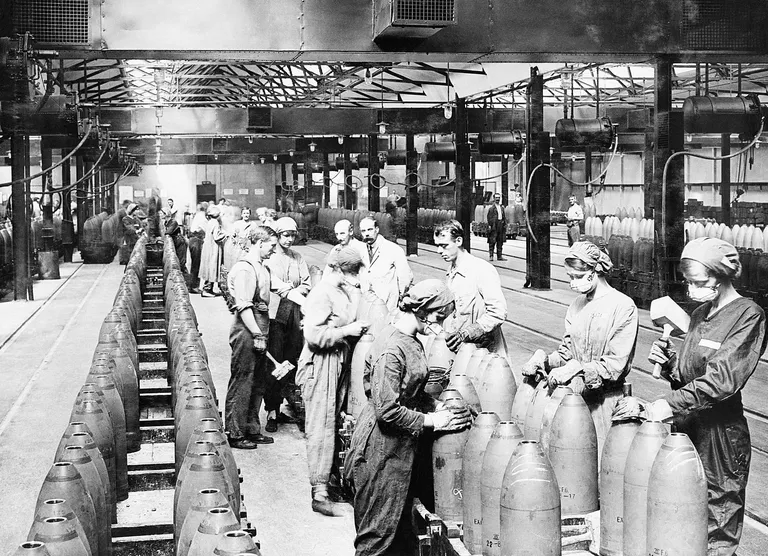
- Fulfilling more ‘domestic’ tasks, some knitted socks for soldiers, did volunteer work, and planted ‘victory gardens’ to help provide food.
- In 1917, as the Army was running out of men, the War Office decided that women could do some front line jobs that did not involve fighting. The Women’s Army Auxiliary Corps (WAAC) was organised into four units: cookery, mechanical, clerical and miscellaneous. Women could do work such as answering telephones and passing messages to soldiers, cooking for men in camps and hospitals, repairing broken down vehicles, etc.
- The Women’s Army Auxiliary Corps became Queen Mary's Army Auxiliary Corps (QMAAC) in 1918. More than 57,000 women served between January 1917 and November 1918.
- In 1915, women in Britain were introduced to Women’s Institutes, which urged women to study home economics. In the same year, suffragette and conscientious objector Sylvia Pankhurst launched The Mothers’ Arms, a mother-and-baby clinic that promoted maternity and child welfare.
- Following a strike led by the Women’s Housing Association in Glasgow, the government introduced the Rent Restriction Act which prevented the eviction of a soldier’s family unable to pay rent.
- Given the rigorous work during the war, women began to demand equal pay. The female employment rate increased from 23.6% in 1914 to 46.7% in 1918. About 40% of female workers were married women.
- In the last year of WWI, women workers went on strike. Munition factory workers in Coventry began the ‘same work, same money’ motto. They were followed by female bus and train workers from Bristol to Birmingham and South Wales.
- Upon discovering that female welders were paid less than men, the Society of Women Welders (SWW) was founded at Sopwith, in 1916. With the help of the Women’s Trade Union Leagues and the London Society of the National Union of Women’s Suffrage Societies, the SWW successfully negotiated an increase from 8 pence to 9 pence per hour. Though not equal to the men’s rate of 12 pence (1s) per hour, it was considered a win at the time.
- Furthermore, female trade union membership in the UK increased from 357,000 in 1914 to over a million in 1918. Men’s membership grew by 44% while women trade union membership increased by 160%.
- When WWI ended in 1918, combined war anxiety and pressures of employment sidelined many women in the workforce. Many withdrew from working and went back to their domestic roles. Many women were employed under an agreement ‘within the duration of the war’.
- With the returning soldiers, women workers were divided. With scarce work opportunities, single and widowed women argued that they should be prioritised over married women.
- During the war, women were accepted as medical students in hospitals. By the 1920s, they were rejected on the grounds of modesty.
- In 1918, the Representation of the People Act granted women over 30 with property the right to vote in a general election. For men, all property qualifications were removed.
- Historians suggest that diverse women’s roles on the homefront showed that they were capable of many things, which would prove important in them winning the vote.
American women during the war
- When WWI broke out in Europe in 1914, US President Woodrow Wilson remained neutral. However, the opinion of the American public started to change after the sinking of the Lusitania, a British ocean liner attacked by a German U-boat in 1915.
- The attack killed 128 American passengers. Furthermore, the Zimmerman telegram between Germany and Mexico was intercepted, which led to America’s formal declaration of war against Germany on 6 April 1917.
- WWI cemented America’s position in world affairs, especially its economic and military might.
- The American counterpart of the NUWSS and WSPU, the National American Suffrage Association (NAWSA) and the National Woman’s Party (NWP) were successful in their suffrage movement in November 1917. On 18 August 1920, the 19th Amendment was ratified and granted all American women the right to vote.
- In April 1917, NAWSA president Anna Howard Shaw launched the Women’s Committee of the Council of National Defense to support the war effort.
- About 8 million women volunteered in the American Red Cross as nurses and aides to soldiers, sailors and other servicemen. Furthermore, the Red Cross organised the Motor Service, which employed female drivers and auto mechanics.
- Both on the homefront and abroad, the Salvation Army or Lassies became a welcome sight for the allied forces.
- About 36 camp libraries were also erected during the war to provide soldiers periodicals and books.
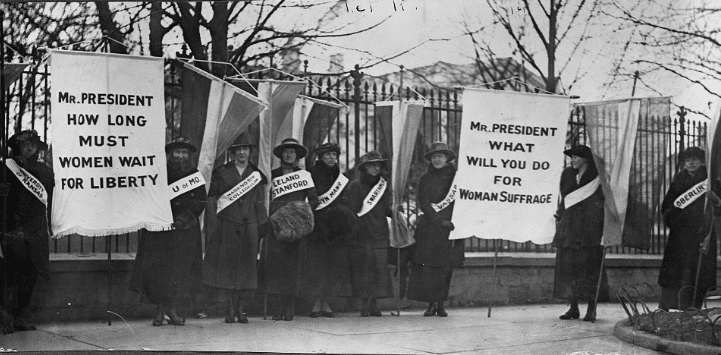
- One of the most remarkable female contributions during the war was from the so-called ‘Hello Girls’ or ‘Cable Girls’ who served as operators for the US Army signal corps. About 7,000 women applied, while 223 were sent overseas. Others served as stenographers, clerks, radio operators, drivers, cryptographers and mechanics.
Women in other parts of the world
- During WWI, American and British women were not allowed to be soldiers. On the contrary, women served as combat troops in Russia, Romania, Serbia and Bulgaria.
- Serbian Maria Bochkareva was known for founding the Women’s Battalion of Death in 1917. Bochkareva received a special dispensation to join the Russian army in 1914. The battalion was made up of some 2,000 women volunteers to shame men for not fighting.
- In July 1917, Bochkareva’s 1st Russian Women’s Battalion of Death participated in the Kerensky Offensive in July 1917.
- In the October 1917 Revolution, the 1st Petrograd Women’s Battalion were among the soldiers who defended the Winter Palace.
- Through the Treaty of Brest-Litovsk, Russian participation in WWI ended on 3 March 1918. In 1920, Bochkareva was executed by the Bolsheviks.
- Another Serbian female officer, Milunka Savić, captured 23 Bulgarian soldiers during WWI. Savić first posed as a man in the Second Balkan War in 1913.
- Eugenie Mikhailovna Shakhovskaya became the first female military pilot when she flew reconnaissance missions for Russian Czar Nicholas II in 1914.
Additional Quick Facts
- In Britain, over 100 day nurseries were established across the country to look for the children of munitions workers. The government did provide some funds for childcare to meet the demand for female workers.
- Working in munitions factories was dangerous. Many were exposed to TNT. Aside from being a highly explosive substance, too much exposure was also poisonous. After the war, many female workers had toxic jaundice.
- While working in munitions factories, women in Britain also engaged in a new leisure and recreation – football. In 1917, the Dick, Kerr’s Ladies FC was founded in Preston.
- In the 1920s, newspaper headlines in Britain talked about a ‘surplus of women’ who would never marry due to the number of casualties of under-45s during the war.
- Due to women’s contributions to the war effort, clothing also evolved. When working on auxiliary services, women wore trousers and looser-waisted clothing.

